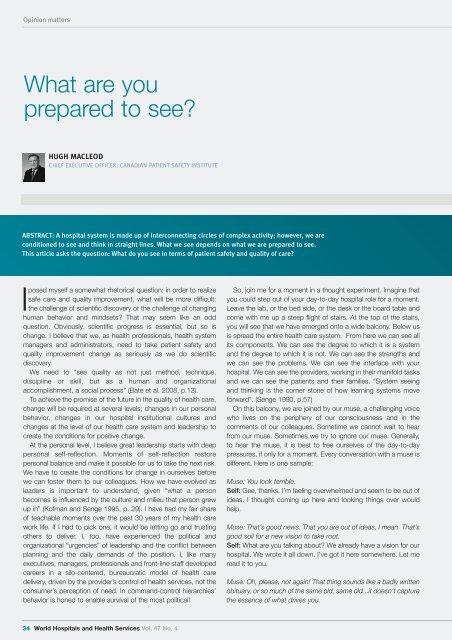web_vol47 4.pdf - International Hospital Federation
web_vol47 4.pdf - International Hospital Federation
web_vol47 4.pdf - International Hospital Federation
You also want an ePaper? Increase the reach of your titles
YUMPU automatically turns print PDFs into web optimized ePapers that Google loves.
Opinion matters<br />
What are you<br />
prepared to see?<br />
HUGH MACLEOD<br />
CHIEF EXECUTIVE OFFICER, CANADIAN PATIENT SAFETY INSTITUTE<br />
ABSTRACT: A hospital system is made up of interconnecting circles of complex activity; however, we are<br />
conditioned to see and think in straight lines. What we see depends on what we are prepared to see.<br />
This article asks the question: What do you see in terms of patient safety and quality of care?<br />
Iposed myself a somewhat rhetorical question: in order to realize<br />
safe care and quality improvement, what will be more difficult:<br />
the challenge of scientific discovery or the challenge of changing<br />
human behavior and mindsets? That may seem like an odd<br />
question. Obviously, scientific progress is essential, but so is<br />
change. I believe that we, as health professionals, health system<br />
managers and administrators, need to take patient safety and<br />
quality improvement change as seriously as we do scientific<br />
discovery.<br />
We need to “see quality as not just method, technique,<br />
discipline or skill, but as a human and organizational<br />
accomplishment, a social process” (Bate et al. 2008, p.13).<br />
To achieve the promise of the future in the quality of health care,<br />
change will be required at several levels; changes in our personal<br />
behavior, changes in our hospital institutional cultures and<br />
changes at the level of our health care system and leadership to<br />
create the conditions for positive change.<br />
At the personal level, I believe great leadership starts with deep<br />
personal self-reflection. Moments of self-reflection restore<br />
personal balance and make it possible for us to take the next risk.<br />
We have to create the conditions for change in ourselves before<br />
we can foster them to our colleagues. How we have evolved as<br />
leaders is important to understand, given “what a person<br />
becomes is influenced by the culture and milieu that person grew<br />
up in” (Kofman and Senge 1995, p. 29). I have had my fair share<br />
of teachable moments over the past 30 years of my health care<br />
work life. If I had to pick one, it would be letting go and trusting<br />
others to deliver. I, too, have experienced the political and<br />
organizational “urgencies” of leadership and the conflict between<br />
planning and the daily demands of the position. I, like many<br />
executives, managers, professionals and front-line staff developed<br />
careers in a silo-centered, bureaucratic model of health care<br />
delivery, driven by the provider’s control of health services, not the<br />
consumer’s perception of need. In command-control hierarchies’<br />
behavior is honed to enable survival of the most political!<br />
So, join me for a moment in a thought experiment. Imagine that<br />
you could step out of your day-to-day hospital role for a moment.<br />
Leave the lab, or the bed side, or the desk or the board table and<br />
come with me up a steep flight of stairs. At the top of the stairs,<br />
you will see that we have emerged onto a wide balcony. Below us<br />
is spread the entire health care system. From here we can see all<br />
its components. We can see the degree to which it is a system<br />
and the degree to which it is not. We can see the strengths and<br />
we can see the problems. We can see the interface with your<br />
hospital. We can see the providers, working in their manifold tasks<br />
and we can see the patients and their families. “System seeing<br />
and thinking is the corner stone of how learning systems move<br />
forward”. (Senge 1990, p.57)<br />
On this balcony, we are joined by our muse, a challenging voice<br />
who lives on the periphery of our consciousness and in the<br />
comments of our colleagues. Sometime we cannot wait to hear<br />
from our muse. Sometimes we try to ignore our muse. Generally,<br />
to hear the muse, it is best to free ourselves of the day-to-day<br />
pressures, if only for a moment. Every conversation with a muse is<br />
different. Here is one sample:<br />
Muse: You look terrible.<br />
Self: Gee, thanks. I’m feeling overwhelmed and seem to be out of<br />
ideas. I thought coming up here and looking things over would<br />
help.<br />
Muse: That’s good news. That you are out of ideas, I mean. That’s<br />
good soil for a new vision to take root.<br />
Self: What are you talking about? We already have a vision for our<br />
hospital. We wrote it all down. I’ve got it here somewhere. Let me<br />
read it to you.<br />
Muse: Oh, please, not again! That thing sounds like a badly written<br />
obituary, or so much of the same old, same old...it doesn’t capture<br />
the essence of what drives you.<br />
34 World <strong>Hospital</strong>s and Health Services Vol. 47 No. 4
















